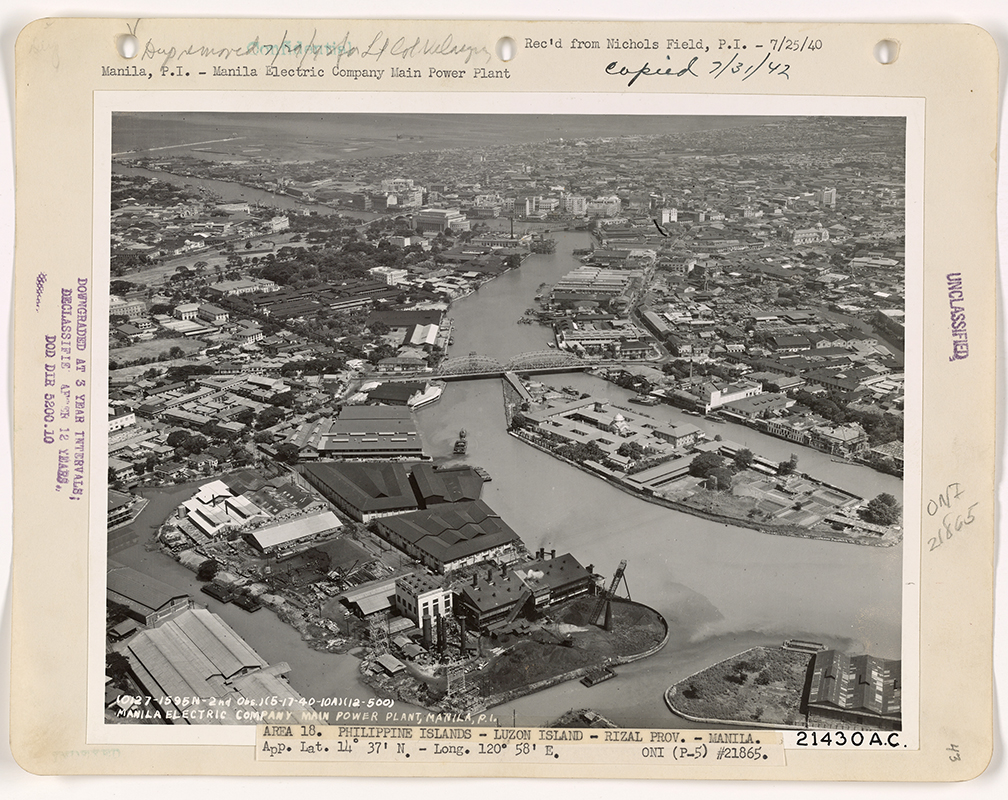by Renato Redentor Constantino | BusinessMirror

Aerial view of Manila Electric Company Main Power Plant (foreground), 1940 US National Archives and Records Administration
As for the future, given the threat humanity faces today in climate change, one would do well to dwell on where and how our electricity was first produced in the Philippines if only to consider the kind of energy system the nation needs if we truly desire reliable, affordable, and sustainable power for the long haul.
The country’s first modern power sector began 132 years ago, on 16 September 1892, to be exact. This was the day Compania La Electricista acquired an electric lighting concession in the Philippines, first established by Millat, Marti and Mitjans, then taken over by Jose Moreno Lacalle and the Tabacalera Company.
Economics historian Benito J. Legarda Jr. tells us the firm was “capitalized at 500,000 pesos [valued at PhP 84.7 million, or US$1.5 million today, of which 50,000 represented the value of the concession, contracts, and preparatory work” contributed by the original concession holders, with 100,000 pesos representing the value of machinery and electrical equipment “contributed by Thomson-Houston International Electric Co. of Boston.” Legarda noted “the rest of the capital would be contributed in cash by the other stockholders.”
Technical details in a Spanish literary magazine in 1902 indicated how La Electricista generated power: It used six 300 horsepower boilers that fed six “steam engines connected to a common axle.” Alberto Dalusung III, one of the country’s foremost energy experts, analyzed the technical details and said it was apparent “The exhaust steam from the engines was cooled by two surface condensers,” each with 500 horsepower, “and two boiler feedwater pumps [that] conveyed the water back in the boilers—making it a closed loop system.” In his analysis, Dalusung said “the engines drive 10 alternators of 60 kW each or 600 kW” and that a few years after commencing operations, the company seems to have “added larger boilers and steam engines” registering capacity at 1,900 kW or 1.9 MW. According to Dalusung, “If the load of the power system was just the 30,000 lights installed in the city,” the rating of the lights would be “around 60 watts or less.”
An American writer, Joseph Earle Stevens, described the illuminating impact of the power station when the “lights were first turned on at the opening of the Royal Exposition in Manila” on 23 January 1895:
“All of the elite of Manila were present at the ceremonies… as … the closing hours of the day arrived, the new electric lights were turned on for the first time. Then all Manila, hitherto illuminated by the dull and dangerous petroleum lamps, shone forth under the radiance of several hundred arclights and a couple of thousand incandescent ones.”
Unfortunately, “the combination of high power plant maintenance costs and the turmoil caused by the Philippine-American War…led to losses for the company.”
In 1900 the entire archipelago was placed by the US under martial law. By 1903, despite spirited Filipino resistance, US occupation troops were firmly established in Luzon as it added more boots on the ground and expanded its presence to other islands. And more industries turned ripe for takeover, including the power sector.
Charles M. Swift, a Detroit lawyer and businessman, came in, “secured a fifty-year franchise to distribute electric lights and power in Manila” and, having acquired the Compania de Tranvias in 1903, founded the Manila Railway & Light Company, which eventually became Meralco.[2]
So much history from an almost empty 5,622-square-meter lot, where Victoria de Hidalgo, a 42-story mixed-use high rise, will be built, on a street that was once plied by tranvias and named after the great painter, Felix Resureccion Hidalgo. But the inquiries certainly shouldn’t stop with Swift.
La Electricista used coal to power up its steam engines, the same fossil fuel that powered the industrial revolution that brought in waves of cheap British cotton fabrics that decimated local textiles such as jusi and piña. The same coal that propelled US warships to Noveleta, Panay, and Lingayen Gulf to offload more US soldiers or bombard Filipino revolutionaries and afterwards head to East Asia to help suppress the Boxer Rebellion, prise open and lay claim to the market of China, and catapult America to its current global gendarme role—the world policeman.
The Philippines became the lilypad to what Cornell University historian Walter Lafeber described as “a historic precedent” after US President William McKinley, after the “Benevolent Assimilation” of the Philippines, decided to send 5,000 American troops from its naval base in Subic to help put down the Boxers in what was then called Peking. McKinley’s move gave birth to modern presidential war powers in the US where “the president without express authorization from Congress, could intervene in a sovereign nation act and, without the nation’s consent, go about reordering its political affairs.”
Connecting threads that link intercontinental resource grabs and wars on nature today should no longer elude us. The emergence of the United States as a global power, surpassing the might and reach of British and French imperial interests, will forever be tied to the role of coal in fomenting disposession in the late 19th century, advancing subjugation early in the 20th century, and fueling global climate chaos today. Wars fought to secure petroleum and gas were preceded by efforts to capture and deploy anthracite and bituminous coal.
Isn’t it time we made the connection? Filipinos continue to refer to large seafaring vessels as “bapor” even though there are no more steamships around: all they remember is the term describing vapor released by steam engines fired up by coal. But they have forgotten history: Subic was first a US naval coaling station just as Guantanamo was, from the outset, designed as a coal depot dedicated to American naval power serving the expansionist ambitions of the United States.
If you wish to raise awareness about climate change, start with Philippine history and open more doors. And if you want to deepen understanding of the past, climate change is a pretty good starting point.
[1] From https://mapcarta.com/N4297354393, accessed 01 June 2024.
[2] See Meralco’s own timeline in https://www.company-histories.com/Manila-Electric-Company-Meralco-Company-History.html. Ludovice and Delina date Swift’s takeover in 1903 but Meralco lists the Detroit businessman as acquiring the franchise to build the Manila electric tramway first, in 1903, with the acquisition of La Electricista in 1904.
Image credits: US National Archives and Records Administration

